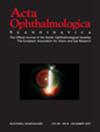AI image analysis tools quantify schisis cystic volume in XLRS retinal dysmorphology
Abstract
Purpose
To provide a perspective on the feasibility and utility of automating image segmentation with artificial intelligence (AI)–based deep-learning algorithms to quantify retinoschisis cystic cavity volume in patients with X-linked retinoschisis (XLRS).
Methods
Review outcomes of two studies published in this journal issue of Acta Ophthalmological on implementing AI–based analysis of Optical Coherence Tomography (OCT) retinal images to quantify structural cavities in XLRS patients. Analyse results of using AI-analytics compared with human manual segmentation for grading the same set of retinal OCT images.
Results
Both papers were successful in developing independent, AI–based algorithms to automate and quantify the extent of schisis cavity spaces in the retina of XLRS patients. Both studies demonstrated that AI analytics can give results comparable to or better than human performance for quantifying XLRS structural dysmorphology. One group then simulated a clinical therapy trial comparing CAI treatment against controls; changes in AI-quantified schisis volume (ASV) proved a better metric as a trial structural endpoint than either central subfield thickness (CST) or central foveal thickness (CFT) as trial structural endpoints.
Conclusions
These two studies independently demonstrated the feasibility of automating the laborious process of quantifying retinoschisis cavity volume in XLRS patients. Further, automated AI-based cavity volume measurement was demonstrated to be feasible as a possible outcome for XLRS therapeutic trials.

 求助内容:
求助内容: 应助结果提醒方式:
应助结果提醒方式:


